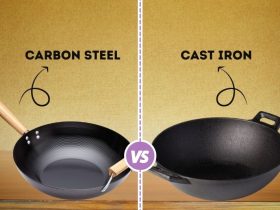Due to the loss of moisture in the air, soft cookies will turn hard. This occurs when the starches in the flour solidify, turning a soft, fresh cookie into a hard cookie.
Hard cookies may also be caused by using too many dry ingredients in the batter. As a result, as the cookies cool, they become firm.
Don’t be concerned if the soft biscuits harden. They can be brought back to life.
How to Soften Cookies
To re-soften your rock-hard cookies, follow these steps
1. Add one piece of bread
 A lidded jar, as well as a piece of bread and your cookies, are required.
A lidded jar, as well as a piece of bread and your cookies, are required.
At the bottom of the jar, place a piece of whitebread. Then, on top of it, arrange the cookies. Allow the container to rest for a few hours after covering it with a lid.
The bread will absorb moisture from the cookies, but the bread will harden.
The flavor of flavored bread may be improved by mixing in some cookies.
2. Add a slice of apple
A container, an apple slice, and your cookies are required.
In the box, place one apple slice with the colored side facing down. Keep the cookies in the package sealed. Allow time for the apples’ moisture to soak into the cookies.
It’s possible that the apple taste will be absorbed by the cookies.
Dip your hard cookies in milk, yogurt, or tea to soften the texture of the cookies.
4. Hard Cookie Reheating

Make use of a paper towel
Hard cookies, a towel, a tray, water, and a microwave are all required.
After placing the cookies on a plate, dampen the towel with water. Before using the paper towel to cover the cookies, squeeze out any extra moisture.
In the microwave, cover the cookie dish with a wet paper towel. It should be heated for approximately 15 to 20 seconds. Remove the cookies after that.
Even if the paper towel smells as delicious as the cookies, you should not consume it. You may toss it out and consume just the cookies.
The only drawback to this technique is that the cookie may get very hot and melty.
Make use of water vapor
To soften hard cookies using this technique, you’ll need the following four items: hard cookies, a microwave-safe plate, water, and a microwave.
On a microwave dish, place the hard cookies and a cup of water. Then, on low heat, microwave the cookies and water for 30 seconds.
The water will boil and steam will be produced as a result of the microwave heat. The steam created by the microwave will heat the water and produce steam. The steam from the cup of hot water will infuse the cookies you’ve put in it. It will also soften and rejuvenate them.
After 30 seconds, check the softness of the cookies. You may keep doing this until you have the texture you want.
NOTICE
DON’T RETURN THEM TO THE OVEN. When softening cookies, this is a frequent mistake. Rebaking cookies makes them more difficult to handle and dehydrates them more.
Before placing them in the microwave, wrap them in wet paper towels. You may also make them harder by microwaving them in a dry towel, much like baking cookies.
How to Make Soft Cookies

Now that you know how to soften cookies, you don’t want to make the same mistake again.
To create soft, chewy, melt-in-your-mouth cookies, you may need to tweak your recipe slightly. Here are a few pointers to get you started!
You may add extra butter if you like. Your butter-to-sugar ratio may be to blame for your cookies’ stiffness after baking. If there is more butter than sugar, a hard cookie will result. If you add additional butter, it will become softer.
Milk may be used to adjust the eggs. If your recipe asks for two eggs, use one egg and one egg yolk instead. Toss the egg white with two tablespoons of milk. The moisture in the cookie dough will be increased as a result of this.
Make sure your baking time is correct. Cookies will harden if they are cooked for too long. Low heat causes them to stiffen, while high heat causes them to burn readily.
When the edges are golden brown, it’s time to take them out. They should have a soft center yet not be stiff. They should be somewhat firm in the center after cooling.
White sugar may be replaced with brown sugar. Brown sugar retains moisture better than white sugar, despite the fact that it tastes different. More chewiness means more moisture.
Place them on a cooling rack to cool. Transfer them to a cooling rack after five minutes. This will keep the bottoms of the cookies from burning.
How to Store Cookies

Allow cookies to cool to room temperature before storing them in any container.
- Place the cookies on wire racks to cool. This enables air to flow around the cookies, preventing them from baking too quickly in a hot pan.
- If you aren’t going to consume the cookies for more than a few days, you may freeze them.
- Place wax paper between the cookies to keep them from sticking together.
- Store soft and hard cookies separately. Hard cookies and soft cookies should not be stored together. The moisture from the soft cookies will soak into the hard cookies, making them hard.
Conclusion
The easiest method to keep cookies from hardening is to avoid items that cause them to harden. Make sure your cookies don’t burn by keeping an eye on them as they bake.
You’ve learned how to soften cookies now. Make sure you follow the recipe’s measurements for all components. Bake cookies on parchment paper to prevent them from burning or sticking to the pan.
Cookies containing dairy ingredients have a higher risk of becoming stale. Consume them when the moment is perfect.






